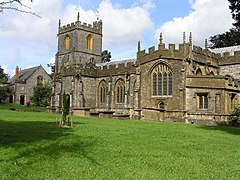Chard, Somerset
| Chard | |
|---|---|
 St. Mary the Virgin |
|
| Chard shown within Somerset | |
| Population | 13,074 (2011) |
| OS grid reference | ST325086 |
| Civil parish |
|
| District | |
| Shire county | |
| Region | |
| Country | England |
| Sovereign state | United Kingdom |
| Post town | CHARD |
| Postcode district | TA20 |
| Dialling code | 01460 |
| Police | Avon and Somerset |
| Fire | Devon and Somerset |
| Ambulance | South Western |
| EU Parliament | South West England |
| UK Parliament | |
Chard is a town and a civil parish in the English county of Somerset. It lies on the A30 road near the Devon border, 15 miles (24 km) south west of Yeovil. The parish has a population of approximately 13,000 and, at an elevation of 121 metres (397 ft), Chard is the southernmost and one of the highest towns in Somerset. Administratively Chard forms part of the district of South Somerset.
The name of the town was Cerden in 1065 and Cerdre in the Domesday Book of 1086. After the Norman Conquest, Chard was held by the Bishop of Wells. The town's first charter was from King John in 1234. Most of the town was destroyed by fire in 1577, and it was further damaged during the English Civil War. A 1663 will by Richard Harvey of Exeter established Almshouses known as Harvey's Hospital. In 1685 Chard was one of the towns in which Judge Jeffreys held some of the Bloody Assizes after the failure of the Monmouth Rebellion.
Textile manufacture was important to the town during the Middle Ages. Chard is the birthplace of powered flight as in 1848 John Stringfellow first demonstrated that engine-powered flight was possible. Percy and Ernist Petter, who formed Westland Aircraft Works, witnessed some of Stringfellow's demonstrations in Chard and often asked for help in the formation of Westland's first aircraft development factory on the outskirts of Yeovil. AgustaWestland now holds the Henson and Stringfellow lecture yearly for the RAeS. James Gillingham developed articulated artificial limbs. Chard is a key point on the Taunton Stop Line, a World War II defensive line.
...
Wikipedia

